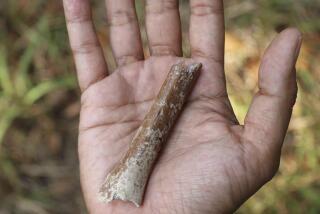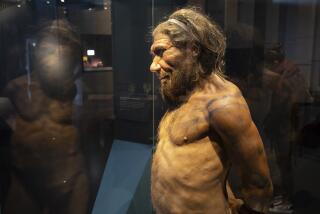Find may prune branches from human family tree
In the humid foothills of the Caucasus Mountains, deep within a carnivore’s bloody lair, an early human ancestor fought a life-or-death struggle, and lost.
He had entered the den on a scavenging mission, possibly with several others. Their plan: Use a stone to scrape meat from the bones of freshly killed prey, then flee before a saber-tooth cat or other giant predator caught him in the act.
“It seems that they were fighting for the carcasses, and unfortunately ... they were not always successful,” said David Lordkipanidze, a paleoanthropologist and director of the Georgian National Museum in Tbilisi.
Now, almost 2 million years later, the stunningly intact remains of that failed foraging mission are causing researchers to question the shape of our ancestral family tree.
Most notable among the fossilized relics are a cranium and jaw of an adult male that together make up “Skull 5.”
In a paper published Thursday in the journal Science, Lordkipanidze and colleagues say that skull and four other fossil craniums recovered at the site contain features previously ascribed to three different species of human ancestor: Homo habilis, Homo rudolfensis and Homo erectus.
The explanation for this is clear, they say: All three species must be one and the same. Differences once perceived to be the mark of separate species are in fact the result of normal variation in physical features, age and gender, they say.
The assertion has struck a nerve in a field in which some paleoanthropologists complain that peers are all too quick to classify small or badly crushed fossil finds as evidence of new species.
“It’s a little like the Emperor’s New Clothes,” study coauthor Christoph Zollikofer, a neurobiologist at the Anthropological Institute and Museum in Zurich, Switzerland, told reporters. “At some point you have to step out of a given perspective and take a new one.”
Reaction to the paper has been strong.
“This is significant,” said Tim White, a UC Berkeley paleoanthropologist who was not involved in the study. “I think that years, even decades from now, this will be seen as a classic turning point. It’s not going to be received well by those who claim our family tree is more like a creosote bush than a saguaro cactus.”
Others say that although the discovery of Skull 5 is a spectacular fossil find, the authors have failed to convince them that it applies to fossils recovered in Africa.
Fred Spoor, a professor of evolutionary anatomy at the Max Planck Institute for Evolutionary Anthropology in Leipzig, Germany, said he’s not about to “say goodbye to Homo habilis and Homo rudolfensis.”
Though the authors focused on the shape of the fossil craniums, that is not the sole indication of a species. Newly evolved features, however, were.
“Whether you’re talking about hominids, ants or frogs, you don’t make a species solely on the basis of overall cranium shape,” Spoor said.
Ironically, Lordkipanidze and his team initially classified their fossil discoveries as a separate species -- Homo Georgicus -- in 2002. After further analysis, they retracted that classification and now describe the fossils as belonging to Homo erectus. All of the fossils were found in Dmanisi, Georgia.
The Dmanisi hominids are the oldest ever discovered outside Africa, and researchers say they were probably among the first members of Homo erectus to begin migrating throughout the Old World. Evidence of Homo erectus has been found from Spain to Indonesia to China.
It’s unlikely the Dmanisi hominids had much in the way of travel plans when they first arrived in Eurasia, researchers said.
“People in Africa didn’t just pack their suitcases ... and leave for Dmanisi,” Zollikofer said. “It was dispersal. There was no aim.”
Each of the recently found skulls is notable for its large face, heavy brow and protruding jaw, as well as a very small brain case -- about one-third the size of modern humans’.
“This is a strange combination of features that we didn’t know before in early Homo,” said coauthor Marcia Ponce de Leon, a paleoanthropologist. “The brain is much smaller than expected.”
The brain size came as a shock to many anthropologists. Previously, many believed that our ancestors required larger brains in order to survive beyond Africa.
In addition to Skull 5’s final foraging mission, researchers said they could decipher other details from his life. At some point, he suffered a terrific impact to his head, which broke his massive right cheekbone. The wound healed and he survived, but the cheek was left permanently dented, like a car fender.
It also appears that the left side of his jaw had suffered deformation from degenerative arthritis.
These details and others, however, would not be useful to researchers unless they could compare the skull with others found at the site.
“It’s the package that’s important as opposed to any one piece,” White said. “What’s often missed in an announcement like this, when the focus becomes the skull or the names applied to the skull, [is] the larger context.... This is the very first evidence of the hominid expansion out of Africa.”
The four other hominid remains found in the area of Skull 5 include a toothless senior, who researchers say may have been cared for by his peers; an adolescent girl; and two other adults.
Lordkipanidze said it was possible that members of the group knew one another, but it was also possible that they ventured into the den separately and died at different times.
--
More to Read
Sign up for Essential California
The most important California stories and recommendations in your inbox every morning.
You may occasionally receive promotional content from the Los Angeles Times.











